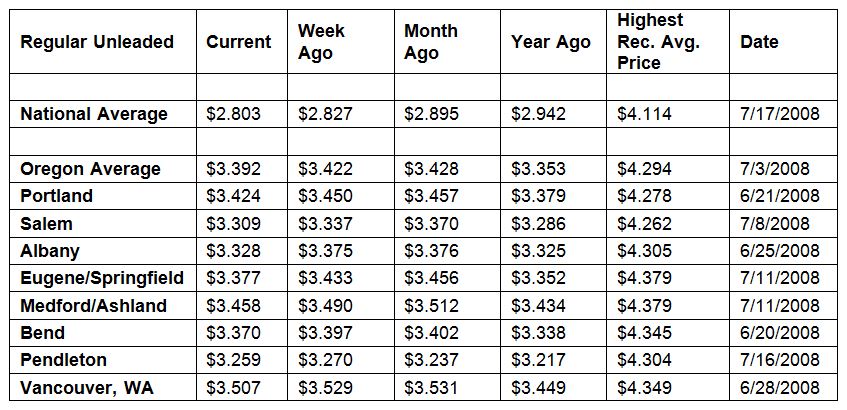PORTLAND, Ore., – The majority of drivers in the U.S. are enjoying falling gas prices. For the week, the national average loses three cents to $2.80 a gallon. The Oregon average also drops three cents to $3.39 a gallon.
“Gas prices should continue to decline in the short term, now that refinery maintenance season has wrapped up,” says Marie Dodds, public affairs director for AAA Oregon/Idaho. “One big factor helping gas prices drop is the price of crude oil which last week plummeted by $6 to $53/bbl, which is one of the lowest prices of the year.”
The national and Oregon averages have backed away from year-to-date highs. The national average peaked for the year so far at $2.90 on May 4. The Oregon average peaked at $3.44 on May 22.
Oregon is one of 37 states and the District of Columbia where prices are lower this week. Delaware (-7 cents) has the largest weekly decrease, while Ohio (+10 cents) has the largest week-over-week increase. This week there are nine states with an average above $3 a gallon, same as a week ago.
Oregon is one of 43 states and D.C. with lower prices now than a month ago. The national average is nine cents less and the Oregon average is four cents less than a month ago. Florida (-20 cents) has the largest month-over-month decline. Wyoming (+11 cents) has the largest monthly gain.
The West Coast continues to have the highest pump prices in the nation with all of the region’s states landing on the top 10 most expensive list.
| Rank | Region | Price on 6/4/19 | |
| 1 | California | $3.94 | |
| 2 | Hawaii | $3.66 | |
| 3 | Washington | $3.52 | |
| 4 | Alaska | $3.49 | |
| 5 | Nevada | $3.47 | |
| 6 | Oregon | $3.39 | |
| 7 | Idaho | $3.18 | |
| 8 | Utah | $3.16 | |
| 9 | Arizona | $3.11 | |
| 10 | Illinois | $2.98 |
California tops the list for the 11th consecutive week with Hawaii, Washington, Alaska, Nevada, and Oregon rounding out the top six. Oregon is sixth for the fourth week in a row. Pump prices in the region have mostly decreased on the week, with California (-6 cents) seeing the largest drop.
The latest report from the U.S. Energy Information Administration (EIA) for the week ending on May 24 shows that West Coast gasoline stocks increased by approximately 700,000 bbl from the previous week and now sit at 28.4 million bbl. The current level is nearly 3 million bbl less than last year’s level at this time, which could cause prices to see moderate increases if there are any supply challenges in the region this week.
Oregon is one of only seven states where drivers are paying more than a year ago to fill up. The national average is 14 cents less and the Oregon average is four cents more than a year ago. Texas (-30 cents) has the largest year-over-year drop. California (+21 cents) has the largest increase.
Oil Market Dynamics
Crude prices suffered a major loss last week, the largest in six months, after new trade tensions emerged between the U.S. and Mexico, a key U.S. trade partner and a major supplier of crude oil. Threats from the Trump Administration to increase tariffs on all products exported from Mexico to the U.S, including crude compound concerns about global economic growth, already at risk due to the U.S. – China trade war. That dispute has prompted market observers to worry about a recession, which could suppress global crude demand later this year.
In related news, EIA reported that crude stocks were mostly flat on the week. Total domestic crude inventories are holding steady at 476.5 million bbl. Additionally, Baker Hughes, Inc. reported that the U.S. gained three oil rigs last week. There are currently 800 active rigs, which is 61 fewer rigs now than last year at this time.
At the close of Friday’s formal trading session on the NYMEX, WTI fell by $3.09 to $53.50. At the close of Monday’s formal trading session on the NYMEX, WTI lost 25 cents to $53.25. Today crude is trading around $53, compared to $59 a week ago. Crude prices are down about 15 percent in the last month and are about $13 per barrel less than a year ago.
Drivers can find current gas prices along their route with the free AAA Mobile app for iPhone, iPad and Android. The app can also be used to map a route, find discounts, book a hotel and access AAA roadside assistance. Learn more at AAA.com/mobile.
Diesel
For the week, the national average slips a penny to $3.08 a gallon. Oregon’s average also loses a cent to $3.29. A year ago the national average for diesel was $3.21 and the Oregon average was $3.43.
Find current fuel prices at GasPrices.AAA.com.
AAA news releases, high resolution images, broadcast-quality video, fact sheets and podcasts are available on the AAA NewsRoom at NewsRoom.AAA.com.
Find local news releases at https://www.oregon.aaa.com/category/news-releases/



